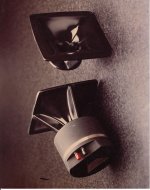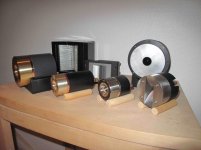jaskierster,
That second response plot looks very nice. Makes me want to use it as a tweeter without a horn attached! The upper octave looks very good for any compression driver, excellent response curve that high.
That second response plot looks very nice. Makes me want to use it as a tweeter without a horn attached! The upper octave looks very good for any compression driver, excellent response curve that high.
I guess a wide band horn CD tweeter would have the same function that the RAAL ribbon tweeter does in Lynn's design. The above plots are a good illustration of the roll off you get with any mid range CD driver / horn, that requires either EQ or a wide band transducer above. I wonder what the optimum Le Cleac'h flare rate would be? A 1200Hz horn would be about 60mm long and 120mm mouth dia. Might go well with the 425 horns - a nice little project for some TD2001 I have. But is there any actual advantage over using say a 500Hz horn? Perhaps directivity would be better (narrower) with the 500Hz flare? I have often wondered what the design objective of the low flare rate short horn stub on old WE tweeters was (WE597).
Truetone,
That driver would work perfect on the horn I show. It is a 1.5khz horn but will work down to about 1.2khz. The advantage is a much wider dispersion pattern in the highs if that is what you are looking for. A longer horn that size will have a very narrow dispersion at high frequency, that is just something you have to decide when you chose a horn for each application.
That driver would work perfect on the horn I show. It is a 1.5khz horn but will work down to about 1.2khz. The advantage is a much wider dispersion pattern in the highs if that is what you are looking for. A longer horn that size will have a very narrow dispersion at high frequency, that is just something you have to decide when you chose a horn for each application.
Well I guess if dispersion is a function of frequency, wall angle and diameter at that point, then to achieve equal dispersion at a nominated cross over point (which is the objective) we need to choose the upper horn curve to achieve this. Tom Danley posted a rule of thumb for this relationship - must look it up.
Wouldn't a real tweeter be better...
...than a 1" compression driver (CD) on a tiny horn?
I mean, the CD, even with a Be diaphragm like the TAD, would still be in break-up mode in the middle of the last octave (10-20kHz).
A GOOD horn tweeter, instead, such as e.g. the top-of-the-line Fostex ring radiators (T900A, T500A-II) or the TAD ET-703 mini-compression driver, or a high-end ribbon, would just be cruising along in the range it was actually designed to cover best.
Marco
...than a 1" compression driver (CD) on a tiny horn?
I mean, the CD, even with a Be diaphragm like the TAD, would still be in break-up mode in the middle of the last octave (10-20kHz).
A GOOD horn tweeter, instead, such as e.g. the top-of-the-line Fostex ring radiators (T900A, T500A-II) or the TAD ET-703 mini-compression driver, or a high-end ribbon, would just be cruising along in the range it was actually designed to cover best.
Marco
The 2" Radians sound plastic now after trying better stuff. Must be the mylar surround. It make them sound toyish. Still smooth and they win over many other drivers. I tested yesterday again if a Beyma TPL would give anything extra. I am in doubt! Make me think 1" CD are superfluous. Must test that again. With drivers like the Community M200 I had to have a tweeter.
...than a 1" compression driver (CD) on a tiny horn?
I mean, the CD, even with a Be diaphragm like the TAD, would still be in break-up mode in the middle of the last octave (10-20kHz).
A GOOD horn tweeter, instead, such as e.g. the top-of-the-line Fostex ring radiators (T900A, T500A-II) or the TAD ET-703 mini-compression driver, or a high-end ribbon, would just be cruising along in the range it was actually designed to cover best.
Marco
Not neccessarily a problem in real life... depending on the amount of info actually present in this range, also when xovered at a fairly high 2,5 - 3k a TAD-TD-2001 (as an example) will have a mutch simpler task than usual... And a TD-2001 sound a lot gutsier than the smaller "above 7k" tweeters mentioned when used this way, in a small JMLC-1400.
Been there, done that etc. etc.
Attachments
An XO seem to take away information where it is at. After my minidsp experiments last week, I think an XO at 2.5kHz will be too noticable. I prefer it higher up, and live with the consequences, with beaming and such. Right now I use a very short, fast opening horn with the 2" Radian 750-8, which BTW has plenty of guts with a little EQ. I am not sure at all that this will work with the GOTO S150 clone, that I am building. It would be convenient to have one less channel to worry about, or maybe use it for an extra bass channel.
Last edited:
Not neccessarily a problem in real life... depending on the amount of info actually present in this range, also when xovered at a fairly high 2,5 - 3k a TAD-TD-2001 (as an example) will have a mutch simpler task than usual... And a TD-2001 sound a lot gutsier than the smaller "above 7k" tweeters mentioned when used this way, in a small JMLC-1400.
Been there, done that etc. etc.
Is that a JA4281B in the picture, back right? If so what are your impressions?
I have got the JA4281B drivers, and used them together with JA6681B / 425 horns. Subjectively I thought them to be a lot like JBL 2405 tweeters - rather piercing to my faded ears. I replaced them with Fostex T900As which are more gentle and pretty much disappear.
marco_gea,
I'm in agreement that a TAD ET-703 is a great driver but at the same time the price has gotten crazy. I bought a pair at one time from TAD for less than $500.00 so the profit margin is astronomical now. This is my target device with the beryllium dome tweeter I am working on building.
At the same time it is a fallacy to think that even a 1" dome tweeter is not in breakup mode in the upper octave. Read any of the Marin Colloms books on High Performance Loudspeakers and you will come away with other ideas of what is happening to the shape of a dome while trying to produce any frequencies that are less than the diameter of the dome.
I'm in agreement that a TAD ET-703 is a great driver but at the same time the price has gotten crazy. I bought a pair at one time from TAD for less than $500.00 so the profit margin is astronomical now. This is my target device with the beryllium dome tweeter I am working on building.
At the same time it is a fallacy to think that even a 1" dome tweeter is not in breakup mode in the upper octave. Read any of the Marin Colloms books on High Performance Loudspeakers and you will come away with other ideas of what is happening to the shape of a dome while trying to produce any frequencies that are less than the diameter of the dome.
Interesting...... I have a pair of old Radian drivers that sound "OK", but there was always something about them that didn't sound quite right. Never could figure it out. I know that the new Radians are well liked, but don't have much experience with them.The 2" Radians sound plastic now after trying better stuff.
Pano,
Yes some of the older Radians had problems with a resonance in the upper frequencies. A friend worked there at one time designing networks to go with the drivers. I could ask him what the fix was, it was caused by a mechanical mistake they made for years.
Yes some of the older Radians had problems with a resonance in the upper frequencies. A friend worked there at one time designing networks to go with the drivers. I could ask him what the fix was, it was caused by a mechanical mistake they made for years.
Kindhornman said:At the same time it is a fallacy to think that even a 1" dome tweeter is not in breakup mode in the upper octave. Read any of the Marin Colloms books on High Performance Loudspeakers and you will come away with other ideas of what is happening to the shape of a dome while trying to produce any frequencies that are less than the diameter of the dome.
Yes, that's why I didn't mention dome tweeters at all. Ring radiators and some ribbon tweeters are not in break-up mode though.
I personally use the Fostex T925A and it sounds (and measures) quite smooth to me.
Marco
- Home
- Loudspeakers
- Multi-Way
- Beyond the Ariel


